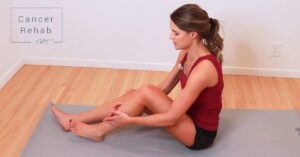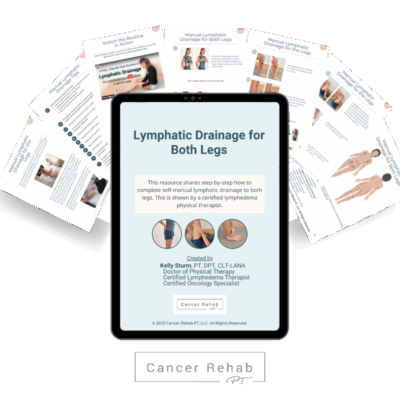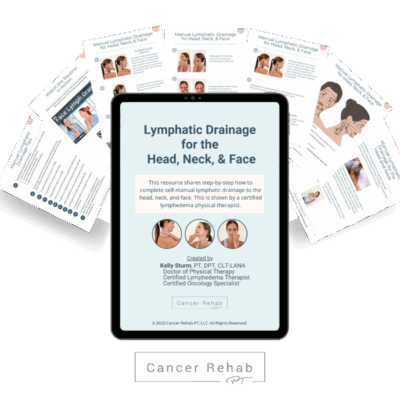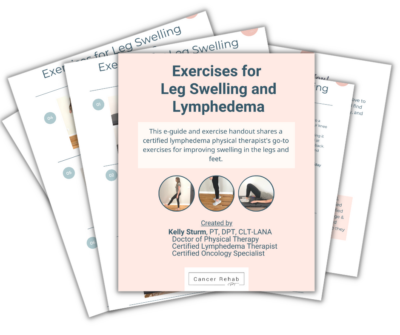Physical exercise is an important part of recovery after a mastectomy or breast reconstruction surgery. It helps build up strength, improve mobility, and feel better physically and emotionally.
Figuring out how to start exercising and what exercises to do after breast cancer surgery can often be confusing. You don’t want to do too much too soon, and you might be wondering: What is the best exercise after mastectomy?
As a Doctor of Physical Therapy and a Board-Certified Oncology Specialist, I often saw people who were told that they have to accept pain and limitations as their new normal after breast cancer. That’s not true.
There are things you can do to build up strength and get your life back. Physical exercise is one of them, and I share more tools and knowledge in my program Breast Cancer Rehab.
What Is a Mastectomy?
A mastectomy is a surgical procedure to remove one or both breasts as a part of breast cancer treatment.
There are different types of mastectomies. In a simple mastectomy, the surgeon only removes the breast tissue. In a radical mastectomy, breast tissue, chest muscles, and lymph nodes are all removed.
Mastectomy can have a significant impact on your body, especially in terms of strength, flexibility, and range of motion in the chest, arms, and neck.
Exercise helps increase movement, makes you stronger, and speeds up recovery. It’s an important part of any breast cancer rehabilitation program.
The Benefits of Exercise After Mastectomy
Doing exercises after breast cancer helps restore your range of motion, strengthen muscles weakened by surgery, and reduce the risk of complications such as lymphedema.
Moving your body also helps reduce stress and anxiety, which are common after breast cancer surgery.
When Can I Exercise After Mastectomy?
It depends on your specific circumstances and the extent of the surgery.
Generally speaking, you can start doing basic exercises a couple of weeks after the surgery, but it’s important to follow your doctor’s advice.
Your first focus should be on gentle movements to prevent stiffness and maintain mobility. You’ll then progress to more active exercises as you heal.
5 Gente Exercises to Try After Breast Cancer Surgery
Here are a few gentle movements to try after mastectomy (or another breast cancer surgery).
You want to start by focusing on managing pain and getting your range of motion back. If you feel discomfort during any of these exercises, scale back or stop exercising completely. You can follow along with the video below!
1. Neck Rotation
We’ll start with simple neck movement. After surgery, your neck may get a little tight, so it’s important to regularly stretch it out.
To do the exercise, stand straight and look to one side, feeling a gentle stretch in your neck. Then, look to the other side. Keep going back and forth, pausing for a second or two. Repeat this exercise 10 times.
2. Shoulder Rolls
Bring your shoulders up toward your ears and move them back down and around, doing shoulder circles. You should feel a gentle stretch across your chest wall. You can go either direction. Repeat this exercise 10 times.
3. Scapular Squeezes
Stand straight and squeeze your shoulder blades. Hold it for a few moments and then relax. Repeat this exercise 10 times and try to do it a few times per day to improve your posture and get some movement in the chest area.
4. Wall Walks
Stand in front of a wall or a door frame and slide your palms up until you feel a gentle stretch. If you feel any discomfort or too much pull, make sure to scale back. The stretch should feel moderate. Repeat this exercise 10 times.
5. Bent over Rows
You can do this exercise without any weight or get a low-weight, 1-2 pound dumbbell. If you don’t have dumbbells, you can also use something from your pantry, like a soup or bean can.
Find a surface you can lean on, such as a countertop or the back of the couch. Rest your forearm on top of the surface and keep your back as flat and parallel to the ground as you can. Make sure your position is comfortable.
Hang your arm down with the weight in your hand. Then, lift it straight up and feel your shoulder blades squeeze. Move your arm back down with controlled movement. Repeat this exercise 10 times and then switch sides.
If these exercises feel too easy for you, I have a video with more moderate exercises after breast cancer that you can try doing once you’re further along in your recovery!
More Exercises After Mastectomy
If you’re looking for breast cancer recovery exercises that you can print out and easily follow at home, I have several digital guides that will be helpful:
- Early Exercises for Breast Cancer When Drains Are Still in Place
- Beginner Stretches for Breast Cancer Recovery
- Advanced Stretches for Breast Cancer Recovery
- Beginner Stretches for Radiation Recovery
- Advanced Stretches for Radiation Recovery
- Beginner Strength Exercises for Breast Cancer Recovery
- Intermediate Strength Exercises for Breast Cancer Recovery
- Advanced Strength Exercises for Breast Cancer Recovery
I also share extensive tools and knowledge in my program Breast Cancer Rehab.
As you progress in your recovery, you can gradually incorporate other forms of low-impact exercise, such as yoga or swimming. Regular physical exercise after breast cancer helps prevent lymphedema, a chronic condition that some people get after going through breast cancer treatment.
Cording After a Mastectomy
Cording, also known as axillary web syndrome, is a condition that can develop as a result of lymph node removal during a mastectomy. You may notice tight, rope-like structures under your skin. These “cords” can cause discomfort and limit your range of motion.
Physical exercise, especially stretching routines, can be very helpful when managing cording. In many cases, with proper treatment, cording gradually improves and even resolves over time.
Managing Scar Tissue Pain
Scar tissue is a natural part of the healing process after a mastectomy, but you don’t have to accept living with pain as your new normal.
Scar tissue massage, Soft Tissue Mobilization (STM), and stretching exercises can all be extremely helpful. Learn more about reducing scar tissue pain after mastectomy.
FAQs
What Are the Restrictions After Mastectomy?
After a mastectomy, it’s important to avoid strenuous activities, heavy lifting, and vigorous exercise for at least 4 to 6 weeks after the surgery. Gentle movement is helpful, but it’s essential to not push yourself too hard to reduce the risk of developing complications. You should also refrain from repetitive arm movements and reaching overhead right after the surgery to avoid straining the surgical site. Listen to your body, consult with your medical team, and stop activities if you feel pain or discomfort.
How Soon Can I Exercise After a Mastectomy?
It depends on your individual circumstances and the extent of your surgery. Your doctor should clear you for gentle exercise when you’re ready, typically within a couple of weeks after the surgery. It’s important to start with light movements to prevent stiffness and improve mobility. You’ll be able to gradually increase the intensity and duration of exercises as your strength and stamina improve. At first, focus on gentle motions like neck rotations, shoulder rolls, and scapular squeezes.
How Long Does It Take to Feel Normal After a Mastectomy?
The timeline for feeling “normal” after a mastectomy varies for each person. Living after breast cancer comes with challenges, both physical and emotional, but the most important thing to know is that you don’t have to accept limitations, pain, and discomfort as your new normal. Physical therapy can be extremely effective and help you improve your quality of life.
Get More Support in Breast Cancer Rehab
No one should have to go through breast cancer alone. I took the exact information and tools I use with my private patients and turned them into Breast Cancer Rehab, an online program that comes at a fraction of the cost of physical therapy.
You can get support with:
- Breast-cancer-related arm lymphedema
- Axillary web syndrome (cording)
- Arm mobility
- Breast swelling/lymphedema
- Scar tissue
- Rehabilitation after radiation therapy
Learn more about Breast Cancer Rehab to recover after a mastectomy.











